Hello, everyone! I’m back to work on my Renfrews!
Look at how the fused pattern pieces cling to the fabric! They’re not ‘sticking’ like they’re sticky, but seem to grip to the surface of the knit fabric and don’t slip around like tissue does. I could probably cut without pinning at all. (If you’re just tuning in, I’m cutting a Renfrew Top and I just fused interfacing to my pattern pieces. I’m posting a few tutorials as I make this top, based on reader feedback and requests!)
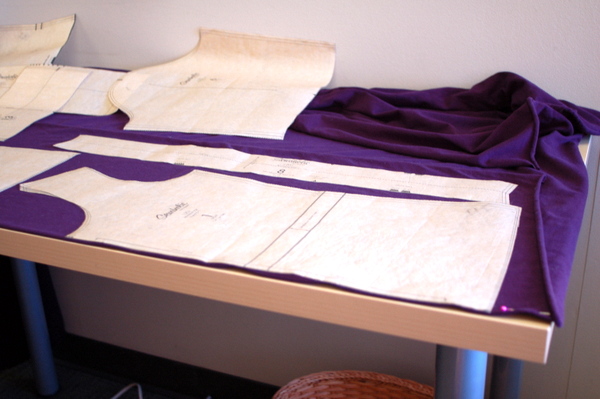
Ok, back to talking about cutting fabric. Just a few little hints I thought of and wanted to pass on today!
One question that people have asked is ‘Why are there so few notches on the Renfrew pattern pieces?’ I’ll tell you why.
The main reason is because I like to snip my notches inwards, about 1/4″ (6mm) into the seam allowance or slightly less. Snipping into knit fabrics can cause the loops to unravel, especially if you stretch the fabric a lot, so we want to minimize the snips as much as possible. I’ve only included them where absolutely necessary. It would be so much worse to pull on your fabric and have several notches stretch out, possibly causing runs in your fabric.
Also, the pieces fit together well and don’t require a lot of notches to line them up properly. Most of the seams are short and straight, and if they’re longer like the underarm and side seam that’s sewn all in one motion) then there’s a major point or intersection to line up, in this case the underarm seam. In the critical places, such as the neckbands or cowl collar, there are notches in place to make sure the band and collar line up.
I jotted down a couple of notes while I was cutting to share today! Here are a few thoughts on cutting knit fabric.
Cutting Notes:
Pin carefully around the pattern piece. If your knit fabric is particularly delicate, you may want to pin only in the seam allowances to prevent holes in the main body. (Not sure if your fabric is delicate? Test on a scrap piece and see if the pin leaves holes.)
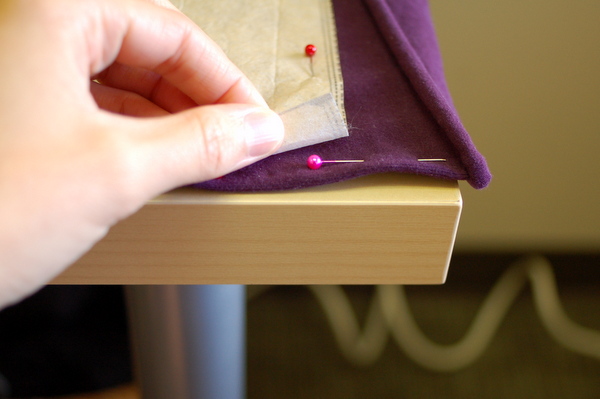
Remove the fold pins if they’re in the way. (If they’re hidden under the pattern piece you can leave them in for now.)
Cut with sharp scissors. Some people prefer a rotary cutter – if that’s you, let us know in the comments! I have one, but never use it because of the cutting mat. (Because the cutting mat is at home and the rotary cutter is here, and I never think about it when it comes time to cut a new project.)
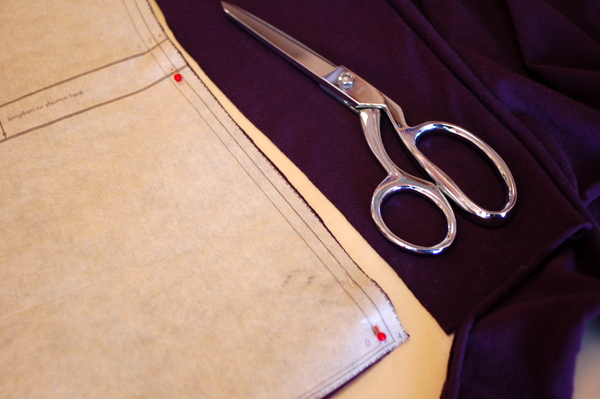
Snip inwards at the notches. Make your snips about the length of the notches, on the shorter side if your fabric is delicate.
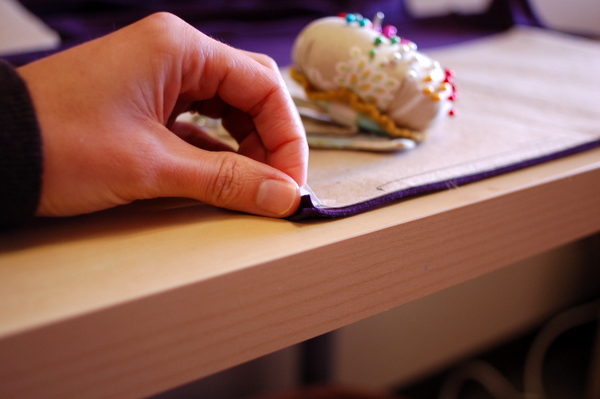
I tend to leave my pattern pieces on top of my fabric as long as possible. Especially if on your fabric, it’s hard to tell which is the right side and the wrong side. I’ll either take out most of the pins except for one or two, or I’ll take out all the pins and just place the pattern piece on top when piling the cut pieces.
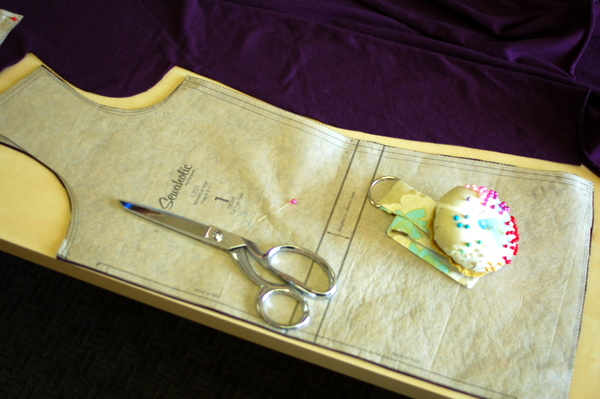
If you are making View C, or creating your own top that includes the cowl collar from View C, be sure to cut two of the collar piece! That’s two collars, both cut on the fold.
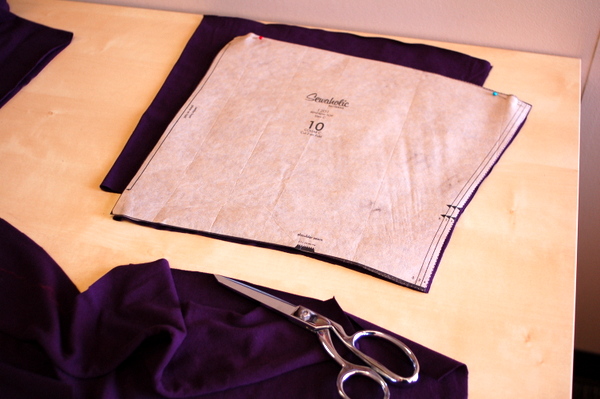
Save your fabric scraps. They’ll come in handy for testing different stitches or thread colours, or even making mini-samples to try out different finishes. It’s much better to try a stitch on scrap, you can stretch the little fabric swatch as much as you want to see if your stitching will break and not worry about ruining your project.
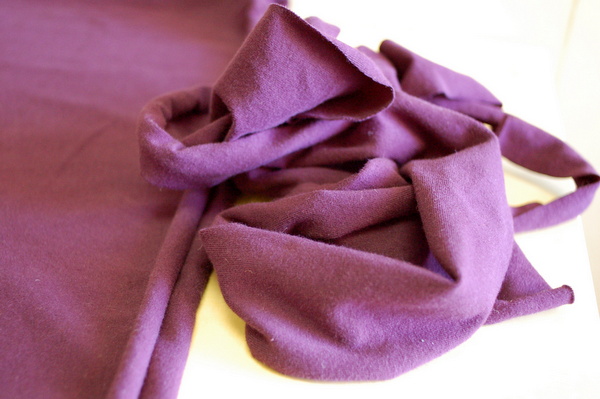
Get the Renfrew top pattern here.

i’m working on an Anise jacket and it’s the first thing i have cut using a rotary cutter. i actually found it very easy and it is so fast (great when you have a jacket’s worth of pieces to cut!). i have heard it is better to use a rotary cutter on knits as you are cutting flat and less likely to stretch the fabric as you cut. not got enough experience to know if this is true or not tho!
That makes sense! I’ve also heard a rotary cutter works well on sheer/slippery fabrics as you’re not pulling on the fabric, for the same reason basically. Good to know it gets faster as you go, especially when you’re cutting a whole jacket! Thanks for the input!
I just cut out my first Renfrew ~ I am soo happy with it. I can’t wait to make a dozen more. I have a confession – I rarely use pins when cutting. Why? Because knits are so forgiving (that’s why knits are my absolute favorite to work with).
I put my tissue on top on top of my fabric and usually use my hand or a few heavy glass jars to hold it in place while I cut around. I prefer using my rotary cutter. So quick and easy but I do keep my scissors handy for those small or point corners.
I DO use pins to see how pieces are held together before I sew. I take them out as I sew and put them in my tomato. I really need one of those magnetic ones.
The only thing that confused me about the Renfrew at first was sewing the neckband. I did view A and at first I couldn’t figure out if it was supposed to be pinned to the outside or the inside. I figured it out after I looked up a tutorial on sewing t-shirts. I figured the neckband was the same concept.
Can’t wait to make more Renfrews :)
So glad you like the pattern! Interesting that you find it easier to cut without pins. It makes sense if your fabric is relatively stable and you’re going to be quick with the cutting! Glad you figured out the neckband as well, it is the same as most tee shirt neckbands, you’re right.
I bought a large cutting mat and a rotary cutter after my first experience of cutting jersey with scissors, which was horrible, and I couldn’t get the jersey to ‘behave’ itself. I haven’t used the cutter and mat much yet, but so far it seems much easier, and much more accurate.
I think I’ll have to try it again, I do like the idea of faster cutting and more accuracy. Thanks for the comment!
I just started using my rotary cutter for cutting out patterns and it’s a dream! No pinning–just a few weights to hold the pattern in place–and so quick! The only disadvantage is that my cutting mat, while quite large, is not big enough for the entire pattern to be laid out and cut at once without moving the mat. That’s a minor inconvenience compared to the amount of time it used to take me to pin out and cut a pattern. Also, I never accidentally pin anything to the carpet anymore (tell me I’m not the only person who does that)!
Ha! I haven’t pinned to the carpet yet as we have wood floors, but I have pinned to my pants when pinning in my lap! It happens. :)
I don’t think many cutting mats are big enough to cut an entire length of fabric, unless it’s short or narrow. Great to hear it makes the cutting faster! You guys are convincing me I should pull it out again and give it another try.
Hehe I’ve pinned my pattern several times to the carpet! I Might have to get a rotary cutter and mat.
I use a rotary cutter all the time. It’s great for knits, smooth cutting, doesn’t pull the fabric out of place. And like Jenny, I use pattern weights (random heavy things I keep in my sewing room) more than pins.
Thanks for the feedback! I’d do the exact same thing for weights, use random heavy-ish things that are lying around as weights instead of buying something special. I don’t sew knits that often but I am in favour of speedy cutting and a method that doesn’t pull the fabric out of place.
I use a rotary cutter, and love it, but have learnt to treat it with a very healthy respect, after taking a slice off my finger with it one time! I suggest that everyone be careful when using these. I always make sure I put the blade guard on, even if I am just putting it down for a second; and i always use a safety glove to protect my hand.
Thank you for the safety tips! I’m totally that accident-prone person who would forget to be careful and slice myself. I know what you mean by the blade guard, what kind of safety gloves do you use? Do you wear them on both hands or just the cutting hand? (Or the non-cutting hand?)
I once left my fingertip too close to the cutting line – I was very lucky the nail was longer than usual because I sliced off the tip of that, not my finger. It was scary how easily it went through the nail though, like a hot knife through butter. Since then I’m very, very careful about where I stick my fingers!
That said though, I do like the rotary cutter. It’s faster and you don’t get the distortion that pins sometimes give. It’s just sometimes a bit of a pain to get all the markings done – at least if you’ve pinned your pattern piece down you know it’ll stay put when you go to mark a dart point!
I highly recommend using a rotary cutter for knits. It makes the process so much easier, and you don’t have to worry about your knit fabric accidentally stretching funny or getting distorted with the scissors. Try out your rotary cutter on knits next time–I think you’ll never go back!
(I use big washers from the hardware store as pattern weights.)
Thanks Trisha! I’m totally going to try it for more knit projects. Plus, I think the mat is wider than my table so I’ll gain a bit of cutting surface as well! (Or I could move it to the floor.. that would also work)
I always use a rotary cutter. It’s so much faster. Plus, it’s quieter, so it doesn’t annoy my husband so much. He’s usually trying to watch TV when I sew in our open floor plan house.
That is a good point! Scissors are noisier, I don’t even think of it but that makes sense. It’s sort of like wooden knitting needles versus metal, the metal clinks when I knit, but the wood or bamboo are basically silent.
Hi…
I was just wondering how you manage the ‘roll’ on the cut edge of the fabric.
Do you have any tips?
hugs
I’ve heard that some people use spray starch and iron the edge so that it doesn’t roll. I’m going to try it out on my next knit project.
Thanks for the tip, I haven’t tried that before! I used to use spray starch to iron creases into my uniform pants when I was in cadets, that’s what spray starch reminds me of! If you get too heavy-handed with the spray starch it can leave a white residue on your fabric that flakes off when it dries. I’d test it on scrap to be sure it wouldn’t affect my fabric, although if you’re making a washable garment and get too starch-happy, it can always be washed out!
I used spray starch yesterday and it didn’t stop it from curling.
Thanks for reporting back! That’s too bad that it didn’t work – I guess starch would would better on lighter-weight fabrics, and might not be forceful enough to work on a curling knit.
Weights, maybe? If I was placing the pattern piece close to the cut edge, the pattern piece and pins would help hold the edge in place. If the edge was rolling but I didn’t have a piece there, I’d use something heavy to weight it down, to keep it from rolling. Or pin it to the under layer of fabric to keep it from rolling, I’d imagine that only a single layer of fabric would roll. Hope this helps!
I used to only cut straight lines with my rotary cutter, but the other day I thought I’d try to use it for cutting pattern pieces, and it was so fast and easy. But after figuring this out I need a bigger cutting mat!
I’ve used a rotary cutter for all knits, for years now. it makes a cleaner cut for knits. I never pin, I use large washers,4″ size I buy them at the hardware store. I also fuse my patterns that I use a lot, to cheap fusible interfacing-I’ve done all these things for years, sure makes it easier to be efficient. you can also trace around your pattern, like Cristine Jonson does, then cut it out after lifting the pattern piece. Truthfully, you can use any object for a weight, even the TV remote! I say Be Creative, enjoy sewing, forget the rules, make it work for you.
I like this: ‘enjoy sewing, forget the rules, make it work for you.’ There’s no right or wrong way to cut your fabric if you get the same end result! (I mean of course there are wrong ways, like ignoring the grain, but not the method.) I did the trace-around a bit on some of my pieces, it makes it easy to cut if your fabric tends to slip around! You’re right, anything works as a weight. I used my phone, my water bottle, my wallet, tape dispenser, anything that will hold the fabric and paper in place!
I love the idea for the fused pattern pieces! I am definitely going to have to try that out! :-)
Thanks! So far, it’s worked really well!
Tasia – I love to sew with knits, and just recently learned a great little trick for that ever-annoying right side/wrong side test. I bought some of the neon colored reinforcement stickers from the office supply store. I think there were about 1,000 for $1. I use them after I’ve cut out the pattern, attaching one to the wrong side of the garment pieces. It is so cool – REALLY shows up, doesn’t mar the fabric, and is very quick & inexpensive. Can’t ask for more, right??
Great idea!
That is a great idea! Definitely place the stickers on the wrong side so they don’t gum up the right side of the fabric, in case they are hard to remove. I’ve done the lazy version with scotch tape, but it isn’t as obvious from far away and it’s easy to forget it’s even there. Thanks for the tip!
This is the most brilliant idea, I’d almost given up sewing black in the evenings with the right/wrong side dilema. Thank you so much.
I have a set of ballpoint pins that work really well on knits and aren’t as likely to leave holes, but I still always pin within the seam allowance and use a rotary cutter and pattern weights to minimize the amount of pinning that I do.
I stopped using pins a while back for all but the most slippery materials. I made some pattern weights out of print corduroy scraps filled with pennies (there’s a tutorial out there somewhere, but I can’t find it now), and I haven’t looked back!
Jenny—the magnetic pin cushions are so worth it. I don’t find nearly so many pins in the carpet as I used to.
I use a rotary cutter for small pieces, and I’d probably use it for larger ones if I had a bigger cutting mat. I do think it’s easy, and it can be so exact because your scissors aren’t sifting and stretching the fabric as you cut.
That’s a good idea to make pattern weights and fill them with pennies – like a beanbag, but much heavier! (Especially since they’re phasing out the penny here apparently..)
I rotary cut all of my patterns, knit or wovens, using pattern weights to keep the pattern in place while I cut! I was a pins-and-scissors gal for the first 10+ years of sewing, but switched to rotary cutting a few years ago and haven’t looked back. I just recently bought a big cutting mat from Nancy’s Notions (36″ x 59″ or some such) and it was so worth the money.
That is a huge mat! Hm, I’ve been a pins-and-scissors gal forever as well. Interesting that you’ve completely switched to all rotary-cutting, all the time!
I LOVE using my rotary cutter for cutting out knits (and some wovens as well). I even use old, dull blades to cut out patterns (I have about 3 different rotary cutters). I have the Olfa cutters in a few sizes as well as the large mats. It makes the process so much easier as I don’t have to worry about distorting the knits much as I tend to do at times when using scissors. I will use scissors to cut as well, but use the rotary cutter mainly on knits, but snip notches and such with scissors.
I use washers from the hardware store but will use pins as well. I often pin one pattern piece down then shift the fabric to pin another piece down if it doesn’t fit all on the table at once….so pins are used in that scenario.
Enjoying your series of posts regarding the Renfrew top and knits!!!
I cut the notches in on patterns, but not on the fabric. Instead, I mark them with a permanent marker.
I’m late to this thread, but I like to cut my knits single thickness, with weights (washers) and electric scissors. Here’s a video of someone using electric scissors on denim http://youtu.be/99JS6aRoJZg?t=5m14s They leave a very nice clean edge with knits too.
I found you while searching for some help with cutting some cotton interlock. I can’t seem to get it flat and since it is my first try on this type of fabric I figured that I could use some help. That search led me to your blog. I’ve signed up and i’m excited to follow your adventures. I was reading this post on knits, etc. and I do see a reference to pins in the fold here but I figured that there was some previous post where you talk about placing those pins in the fold of the knit when preparing to cut out the pattern. I haven’t been able to find where that might be. That’s where I am now. I’ve spread out the fabric on my mat but it seems that every time I try to get the folds out and get the cotton interlock to lie flat, another fold pops up. Where might I find some hints as to how to get this fabric yardage ready to go? Thanks!
Hi Lou Ann! Here is the post here – http://sewaholic.net/cutting-knit-fabric/
Cotton does tend to stick to itself a little, so you’re right, there will be little folds that need to be smoothed out as you go. It’s normal to have to do that, but as long as you make sure there aren’t folds under the pattern pieces, you’ll be cutting the pieces to the right dimensions. Hope this helps!
Hello Tasia, I just found this site whiles I was searching for fashion terms, and I find sewaholic to be of the best solutions to my search especially “stitch in the ditch” in fact it was a definition with demonstration, easy to understand and simple at sight. Thank you very much and I hope you will help me build a career in fashion design.